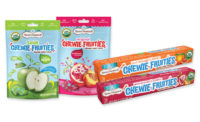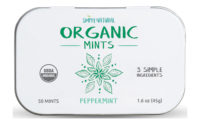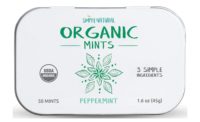The proof is in the organic and all-natural pudding.
With greater access to information — and increased demand for transparency — consumers are seeking food with clean labels and a clear history. As a result, sales for organic food products continue to blossom, reaching $39.7 billion in 2015. That’s up 11 percent from 2014, according to the Organic Trade Association’s 2016 Organic Industry Survey.
Organic snack food hit $2.3 billion in 2015, up 14 percent from the year before. That’s not a surprise to Michael Sands, ceo of Stamford, Conn.-based YumEarth.
“The natural industry has crossed over into mainstream retail, and it exists across many channels,” he says. “You can find it in c-stores. Natural and organic sets are everywhere, since consumers are demanding them, and the availability is increasing.”
Sands noted consumers who fall into the “LOHAS” category — lifestyle of health and sustainability — are concerned about the types and number of ingredients that are used in a product and what impact they pose on the environment. While LOHAS consumers appear in every demographic, Millennials, Gen X and Gen Y shoppers with disposable income and families of their own are leading the charge, says Antoine Ambert, director of marketing for San Francisco-based Alter Eco.
“Millennials with the purchasing power are looking for products where they don’t have to compromise,” he says. “Organic is a good answer to that because with organic comes a specific choice of ingredients.”
To be certified organic under the U.S. Department of Agriculture, products must not contain ingredients produced with pesticides, synthetic fertilizers, sewage sludge, genetically modified organisms (GMOs) or ionizing radiation.
Natural, meanwhile, isn’t as easy to define. The Food and Drug Administration (FDA) doesn’t have an exact definition, and the agency even solicited public comment on defining characteristics for natural through May 2016. Generally, the agency has not objected to use of the term “natural” as long as a product has no added color, artificial flavor or synthetic substances.
Whether or not a product has been certified, organic and natural foods imply a higher level of health. That also goes for sweets, says Laina Malnight, marketing manager for Irvine, Calif.-based Chocxo.
“Organic candy, for the most part, is giving consumers a permissible indulgence,” she says. “You can buy the candy or the chocolate, but you feel a little better about it because it’s organic and you know where the ingredients come from.”
Nonetheless, finding organic ingredients can be tricky, manufacturers say. Suppliers continue to add organic offerings, but it’s not always enough.
Malnight noted Choxco has difficulty at times sourcing organic ingredients such as almonds, coconut and caramel. She added the company considered making a hazelnut paste item but struggled to find hazelnut paste in an organic variety.
“It does present challenges, but we’re really dedicated to providing an organic product, so we do try to work around that,” she says.
Ambert agreed, adding the more candy manufacturers ask suppliers for organic ingredients, the more suppliers will rise to fill those gaps.
“We’ve accepted that challenge, and it’s been working,” he says. “We’re going to keep pushing the envelope that way. For a company like us to demand that, it’s also creating that demand. We hope that suppliers are going to hear it and change their practices.”
Sourcing organic cocoa, chocolate and inclusions isn’t the only concern. Organic colors and flavors are often more muted than their artificial counterparts, making it difficult to reach the same level of brightness and flavor, Sands says. That’s tough for a manufacturer that produces sweets directed largely toward children and families.
“Nobody is going to eat an organic product unless it tastes great, That’s your cost of entry,” Sands says. “Once you make it taste great, you have to make it look as appetizing as possible, which is difficult to do when you can’t use artificial colors and flavors. You have to push that limit as much as you can.”
Sands noted YumEarth emphasizes making organic and allergen-free versions of popular treats such as gummy bears and lollipops. Earlier this year, YumEarth introduced a line of organic, gluten-free licorice that includes a black variety for die-hard fans. The black licorice, which was set to appear in YumEarth’s online store at the end of June, is also free of additives and chemicals considered harmful under California’s Proposition 65.
YumEarth also introduced Sour Twists and Sour Beans in the first quarter of 2017, and organic candy corn will roll out later this year.
“We like to take on challenges of mainstream ideas and bringing them to life,” he says.
Malnight also cited continued interest in dark chocolate for its quality, flavor and health benefits. Choxco makes an assortment of dark chocolate tasting squares, 35-calorie pieces meant to satisfy a consumer’s need for a little bit of chocolate.
“You can certainly limit your portions, which is something we feel pretty passionately about,” Malnight says. “You can enjoy chocolate as part of a healthy diet as long as you keep it responsible.”
Alter Eco has also responded to increasing demand for dark chocolate. In April, the company introduced the Super Blackout Bar, made with 90 percent cocoa sourced from Ecuador, as well as 58 percent cocoa Dark Mint Truffles.
Ambert also pointed to combining salt and chocolate, a trend that has become standard. Alter Eco also introduced this year the Dark Salted Almonds Bar and the Dark Salt and Malt Bar, made with 70 percent cocoa, organic malt crumbs and Fleur de Sel de Guérande sea salt.
“Salt and chocolate is definitely now a classic on the market today, even though it’s been a few years,” he says. “A salted bar is a best seller for so many brands, including ours.”
While paying attention to flavor and health is key in the organic candy category, Ambert pointed to another cause that goes hand in hand: environmental friendliness. In addition to complying with standards set out in organic certification, Alter Eco wraps its bars in recyclable paper and its truffles in compostable twist wrap.
“Our planet needs consumers who are more conscious in their purchases,” Ambert says. “I wish for that to continue, and I’m actually very confident that it will.”









